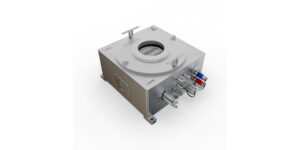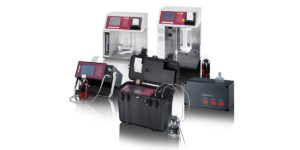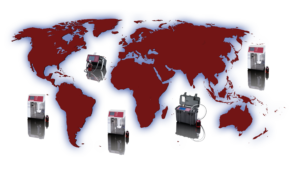Fluid contamination can be measured by various different analysing methods. In this blog post, we compare the laser optical method of light extinction against pore blockage.
How does the Light Extinction method work?
The illumination source is a laser diode. The laser light beam is collimated by a lens array and formed to a straight and flat beam focused by a transfer optic at the orifice. The beam passes through the measuring cell and interacts with a photo diode. The photo diode measures the light intensity behind the contaminated fluid stream in the orifice. The photo diode operates in a photo conductive method which delivers a current proportional to the incident light intensity. Each single particle flowing through the measuring cell creates a change of current on the photo diode; the sensor electronics evaluate this change of current as a particle signal. The shadow surface represents the size of the particle.
A light extinction particle counter measures particles in multiple size areas. Each single particle in the fluid is detected and assigned to a specific size channel. After measurement, the measuring results are reported as particle counts for the individual size channels. When reporting the results cleanliness class standard, the measurement results are presented in simplified form either in 6 size classes between 4 and 70µm(c) (A-F) or in 5 size classes between 6 and 70µm(c) (B-F). The triple code as per ISO 4406 reports three size channels of 4, 6 and 14 µm(c). The optical PAMAS particle counters exceed the requirements of common cleanliness standards by providing a detailed particle size distribution of up to 32 size channels.
How is the pore blockage technique measured?
In this filter blockage technique, the sample fluid is led through a membrane with a defined pore size (e.g. 10 µm). Particle sizes exceeding the pore size are separated and trapped on the surface of the membrane, so over time, the pores of the membrane filter become blocked by particles.
Two different variants can be used in the pore blockage technique:
- If the flow rate is kept stable, the increase of the differential pressure can be measured.
- Conversely, the flow rate reduction can be determined if the pressure drop is maintained at a constant level.
At constant flow, an increase of pressure can be observed during measurement. This is due to the open pores on the membrane becoming blocked. Due to the reduction of the number of pores, the sample flow becomes more and more blocked and the differential pressure increases. Conditions are the other way round at constant pressure: The flow rate gradually decreases while the filter becomes more and more blocked. With the aid of a mathematical formula that are specific to the manufacturer, the measuring data is then converted into corresponding cleanliness classes.
Compared to particle counting with the light extinction method, the pore blockage technique has a single benefit: The measuring result is hardly affected by aeration of gas bubbles or by free water. However, the measuring result might be affected by insoluble additives that are sticking in the filter.
Furthermore, the filter blockage method is only semi-quantitative as it provides information on the whole degree of contamination, whereas it does not measure quantity and size of the individual contaminants. Single particle measurement and precise knowledge on the particle size distribution can be obtained only through the light extinction technique. The pore blockage method is also restricted to few particle sizes. Particles smaller than the pore size cannot be detected. The filter blockage technique can also be affected by the fluid viscosity: Different sample viscosities might affect the differential pressure at constant flow rate. This leads to false measuring results. If changes in the fluid viscosity might occur, the pore blockage method can only be applied at constant pressure and variable flow rate (by measuring the differential flow rate). In addition, the pore blockage method does not detect liquid contamination (e.g. oil contamination in hydraulic systems carrying water-glycol) and thus deceives the user into believing that his system is actually clean.
Conclusion
Whereas the pore blockage technique only allows a coarse indication of contamination, light extinction sensors measure the dimensions of every single particle in the sample fluid. The pore blockage technique does not measure individual particles, it merely calculates the differential pressure related to a specific particle size. The pore blockage technique must not report particle measuring results as per cleanliness standards. A standardized report of contamination results as per SAE AS 4059 can ONLY be achieved with an optical particle counter, calibrated according to ISO 11171. Precise information on the size of individual contaminants is an indispensable prerequisite in many applications. The light extinction method is the only suitable method for these applications.
You will find more information about PAMAS particle counters here.
© Image by Chokniti Khongchum from Pexels




